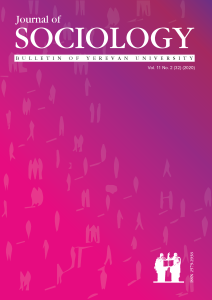Mass Communications: From Classics to the Virtual Models
DOI:
https://doi.org/10.46991/BYSU:F/2020.11.2.059Keywords:
Mass communication, virtual communication, virtual environment, models of communication, feedback, self-presentation, virtual as the messageAbstract
The article is devoted to the widespread use of mass communications and their virtual models, features and limitations, as well as the comparison of virtual and classical models. To study virtual communications, it is not enough to describe the corresponding processes within the framework of classical models, as well as the communication elements included in them. In order to fully describe modern communication processes, it is proposed to supplement the classical models with such elements as feedback, perception and self-presentation of the user, as well as the virtual communication space.
References
Nastasia, D. & Rakow, L. (2005). What is communication? Unsettling a priori and a posteriori approach, The International Communication Association, Philosophy of Communication Division, 4-10
Santandreu, R. J., Shurden, S. & Shurden, M. (2011). The complexity of communication, Journal of Case Studies in Education, Lander University, 2. Retrieved from https://files.eric.ed.gov/fulltext/ EJ1057194.pdf, p. 5-8.
Atanesyan, A.V. (2008). Aktual'nye problemy sovremennykh politicheskikh i konfliktnykh kommunikacii. Yerevan. Izd.-vo EGU, 9-15
Relvin, R. (2012). Cognition: Theory and Practice, Hardcover – International Edition, 20-30
Broadbent, D. E. (2011). Perception and communication, Applied Psychology, Unit of the Medical Research Council, Cambridge, National Federation of the Blind (NFB), 10-11
Amodu, L. O. (2006). Perception: A Determinant for Effective Communication, An African Journal of Philosophy, 9 (1), 148-153. Doi: https://doi.org/10.4314/sophia.v9i1.38774
Pochepcov, G.G. (2001). Teoriya kommunikacii. Moscow, Refl-buk, 40-48
Kulczycki, E. (2014). Communication History and Its Research Subject, Adam Mickiewicz University, 133
Adhikary, N․ M․ (2008). The Sadharanikaran Model, and Aristotle's Model of Communication: A Comparative Study, Vol. 2, No. 1, Serial No. 2, 75. Doi: https://doi.org/10.3126/bodhi.v2i1.2877
Lasswel, H. (1948). Structure and Function of Communication in Society, (ed. by J. Bryson. The Communication of Ideas), N.Y. 30-35
Fedaghi, S. A. (2012). A Conceptual Foundation for the Shannon-Weaver Model of Communication, computer Engineering Department Kuwait University, International Journal of Soft Computing, 18-25
Schramm, W․ (1963). The Science of Human Communication, Basic Books, Inc., New York, 40-45
Kent, G. (1967). Graphic conceptual models and communication theory, Boston University, 18-30
Lacy, S. (1989). The Westley-MacLean Model Revised: An Extension of a Conceptual Model for Communication Research, School of Journalism, Michigan State University East Lansing, Michigan, 20-24
Lakkaraju, K., Sukthankar, G. & Wigand R. T. (2018). Social Interactions in Virtual Worlds: An Interdisciplinary Perspective. Cambridge University Press, 13-18. Doi: https://doi.org/10.1017/9781316422823
Sparso, J. (2004). On Synchronous and Asynchronous Communication Paradigms, Technical University of Denmark, 30-40
Kumar, K. A., Natarajan, S. & Acharaya, B. (2017). Computer-mediated communication: A path-way to analyze social media communication trajectories, serials publications, 197-199
Innis, R. E.(2011). Signs of feeling: Susanne Langer's aesthetic model of minding, University of Massachusetts Lowel, PA 29, 50-52
Brindha, K. & Hanyu Yan, K. (2017). Virtual Reality as a Communication Process: User Perceptions and Experiences, Sweden, Linnaeus university, 60-65
Lacy, S. (1989). The Westley-MacLean Model Revised: An Extension of a Conceptual Model for Communication Research, School of Journalism, Michigan State University, East Lansing, Michigan, 20-24
Reicher, S. D., Spears, R.& Postmes, T. (1995). A Social Identity Model of Deindividuation Phenomena, University of Amsterdam, European Review of Social Psychology, 162-168. Doi: https://doi.org/10.1080/14792779443000049
Walther, J.B. (1996). Computer-mediated communication: Impersonal, interpersonal, and hyper-sonal interaction, University of California, Santa Barbara, 28-35
Spitzberg, B.H. (2000). A Model of Intercultural Communication Competence, WR Cupach SAGE Publications, Incorporated, 375-387
Spitzberg, B.H. (2006). Preliminary development of a model and measure of computer-mediated communication (CMC) competence, Journal of Computer-Mediated Communication 11 (2), 629-666. Doi: https://doi.org/10.1111/j.1083-6101.2006.00030.x
Marchand, P. (1998). Marshall McLuhan: The Medium and the Messenger, The MIT Press, 111-121
Bubas, G. (2006). Competence in Computer-Mediated Communication: An Evaluation and Potential Uses of a Self-Assessment Measure, International Communication Association Conference, Dresden, Germany, 5-15
Downloads
Published
How to Cite
Issue
Section
License
Copyright (c) 2020 Anrieta Karaperyan

This work is licensed under a Creative Commons Attribution-NonCommercial 4.0 International License.








